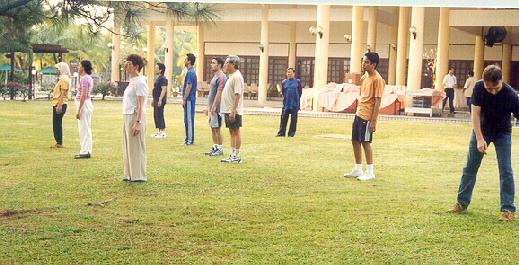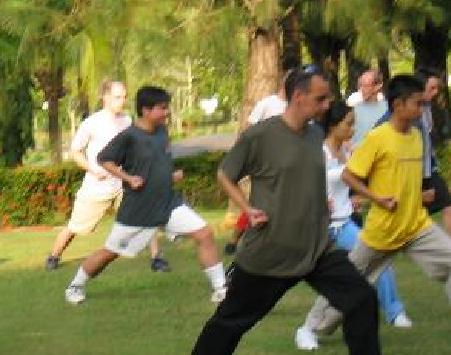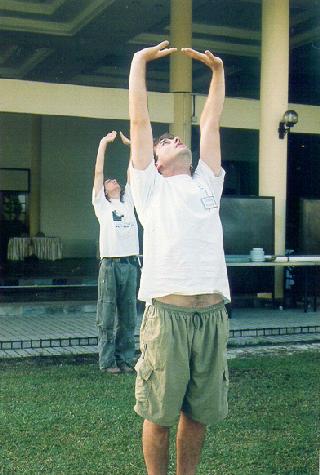December 2005 (Part 3)
SELECTION OF QUESTIONS AND ANSWERS

Question 1
I am not sure what the best way to strive for enlightenment is.
— Steeve, Canada
Answer
The best way is to learn from the greatest teacher who teaches enlightenment, i.e. the Buddha himself.
The Buddha has very kindly made understanding simple for us by summarizing the way to enlightenment into three steps
- Avoid all evil
- Do good
- Cultivate the mind
There are numerous ways to cultivate the mind. In Buddhist terms these countless ways are figuratively described as 48,000 spiritual doors. In Buddhist tradition these countless spiritual doors range from the most “simple” in the chanting of “Namo Amitabha Buddha” to the most “advanced” in Zen meditation.
Chanting "Namo Amithaba Buddha" does not lead directly to ultimate enlightenment, but to the Western Paradise where one can cultivate in ideal conditions leading to ultimate enlightenment.
There are also countless non-Buddhist ways to enlightenment. Placing one's complete faith in Christ, practicing yoga, praying to one's chosen gods or deities are some of the ways.
Question 2
Have you thought of making a video of your Intensive Chi Kung Course? I would certainly be interested in buying it.
Answer
No. Chi kung is an internal art where the essence of the teaching is formless or invisible. Videos can only show the forms. One may learn and practice the forms correctly from videos, yet may not be practicing chi kung at all. This, in fact, is quite common, even when students learn from instructors.
Then, why do I have so many video clips on chi kung as well as Shaolin Kungfu and Taijiquan on my website? It is because these video clips serve other very useful purposes, such as
- To remind Shaolin Wahnam students of what they have learnt or will learn.
- To illustrate in pictures what we say in words. For example what we say about applying kungfu patterns for combat or generating an energy flow makes sense when videos are provided.
- To help others who are already initiated and who may be interested in our methodology in their own cultivation and development.

Participants at an Intensive Chi Kung Course in Malaysia enjoying a gentle chi flow
Question 3
I know there is a sea of information out there and I want to make the right choices for me and my family and I am just not sure where to start.
Answer
Indeed, ours is an information age. Today you can get from a good book or from the internet what many in the past would be ready to spend many years or even risk their lives to get.
Nevertheless, there is also a lot of rubbish out there. Not only most people may be unable to tell the rubbish from the real stuff, when followed blindly the rubbish can be very harmful.
The following are some useful ways whereby you may tell the real stuff from the rubbish
- Ascertain the author's credentials.
- Compare what one author says with what is traditionally established by masters.
- Check the result of those who follow the author's advice.
Question 4
What do you think about zhan zhuang qigong?
Answer
“Zhan zhuang” or stance training is a very powerful genre of chi kung to develop internal force as well as mental clarity. It was probably the single most important methodology used by past kungfu masters in their internal force training.
But zhan zhuang must be practiced correctly. If practiced incorrectly it can result in very harmful, and often insidious, side effects. It is easy for self-taught students to practice zhan zhuang wrongly.
Zhan zhaung is not just one exercise, but a category of exercises where the practitioner remains at the same poise for some time. Some famous poises commonly used in zhan zhuang are Horse-Riding Stance, Golden Bridge, Three-Circle Stance, and Three-Body Stance.
Question 5
What do you think about Grand Master Bodidharma's 18 Hands of Lohan? Is there a document that I could buy, a video that shows me how to do it? Can someone actually attain ultimate enlightenment using these techniques?
Answer
The Shaolin Eighteen Lohan Hands first taught by the great Bodhidharma and has been passed down the centuries to us today is one of the best sets of chi kung exercises in the world. Hence, we in Shaolin Wahnam use it as our basic set of chi kung exercises. Three of these eighteen exercises are chosen for my Intensive Chi Kung Course, and have brought tremendous benefit to many people.
There are many books written in Chinese on the Eighteen Lohan Hands. However, almost all these books describe only their outward forms. The internal aspects, which are the essence of these exercises, are absent. Thus, most people learning from the books miss the best benefits of these exercises.
Yes, it is possible to attain ultimate enlightenment using these chi kung exercises, although they are normally practiced as a preparation for Zen meditation which is the established approach to attain ultimate enlightenment.
It is helpful to point out that the term “ultimate enlightenment” as used by Buddhist masters refers to the most supreme spiritual attainment where cultivator becomes the Spiritual Buddha. In other words the cultivator does not exist any more in any phenomenal realms but become one with Cosmic Reality. In Western term he becomes one with God.

Zhan zhuang or stance training is an integral part of Shaolin and Taijiquan training in Shaolin Wahnam. Here participants to an Intensive Shaolin Kungfu Course practice zhan zhuang, and the poise used here is the Bow-Arrow Stance.
Question 6
What are the significant reasons and effects of:
inhaling through the nose and exhaling through the mouth?
inhaling with the tongue touching the upper gums and exhaling with the tongue touching the lower, as in the case of Forceful and Gentle Small Universe.
— Song, Australia
Answer
Inhaling through the nose and exhaling through the mouth are natural processes, and promote good breathing method and health. It is the most common mode of breathing in chi kung.
Inhaling with the tongue touching the upper gums and exhaling with the tongue touching the lower helps to bridge the upper gap between the Ren and Du Meridians, whereas holding up the anus helps to bridge the lower gap. These two techniques are used in the training of the Small Universal Chi Flow. But once the Small Universe is achieved, i.e. once chi flows smoothly and continuously round the Ren and Du Meridians, it is not necessary to consciously pay attention to the tongue and anus positions.
Question 7
My hope in doing chi kung is to develop strong healing power as well as internal force. With so many types of breathing exercises described in your book, can you suggest a program whereby I can follow and train diligently in order to achieve my aim?
Answer
If you wish to be a healer or to develop internal force, it is strongly advised that you learn from a master. Self-taught training may result in your harming others in your healing, or harming yourself in your internal force training.
If you have the appropriate skills, any breathing method can help you to realize your aim, although some methods may be more suitable for particular needs and conditions. It is inadvisable to learn on your own from a book. If you are really dedicated to realizing your aim, you should seek a master or at least a competent instructor.

Participants at an Intensive Chi Kung Course in Malaysia practicing “Lifting the Sky”, the first and most popular of the Eighteen Lohan Hands
Question 8
I am currently reading Grandmaster Wong Kiew Kit's book, “The Complete Book of Shaolin”, and I have a question concerning meditation. I am in the very beginning of my training and know that by not performing the meditation properly I could be missing out on all of the potential of the meditation and in the advanced stages it can even be dangerous to do so improperly! So how do I properly go from a deep meditative state of mind to regular consciousness without disturbing vital energy flow.
— Brandon, USA
Answer
Although it looks simple and is actually simple, meditation is a very advanced art, and therefore must be learnt from a master, and not haphazardly on your own. Incorrect practice, which is likely if you do not have proper guidance, may result in serious, but often insidious, side-effects.
If you learn from a competent instructor you will soon find that your question is irrelevant or meaningless. In principle, it is like asking how you go from a quick running step to a slow walking pace, or how you go from your house to your school. The answer is that you just do so smoothly, which may not make any sense to those who lack the actual experience but is natural to those who do so.
Nevertheless, many meditators as well as chi kung practitioners smoothen the transition from a deep meditative state of mind to regular consciousness as follows. Rub the palms, and warm the eyes with the palms as the eyes are open. Then massage the face, loosen the hands and legs, and walk about briskly.
LINKS
Selected Reading
- A Discussion of Shaolin Kung Fu Combat Philosophy — Sifu Andrew Barnett
- The Legacy of Shaolin Wahnam — Sifu Anthony Korahais
- A Glimpse into a VIP Taijiquan Course
- Learning Free Sparring in Three Days!
- A Felling Technique from Shaolin Kungfu
- Single Knife against Spear (Part 5)
